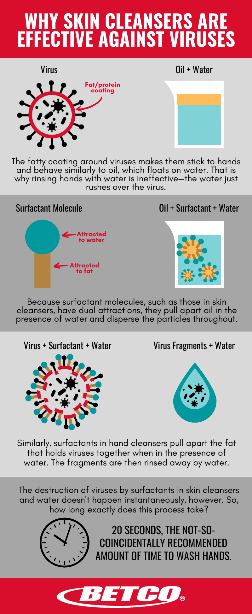The Chemistry At the beginning of the COVID-19 pandemic, we published an infographic explaining why skin cleansers and hand soaps are effective against viruses like SARS-CoV-2. As indicated in that infographic, surfactant molecules are amphiphilic, meaning their heads are “water loving,” and their tails are “water hating.” That’s how, in water, they pull apart oil and the fat/protein coating of enveloped viruses, including coronaviruses, H.I.V., the viruses that cause hepatitis B and C, herpes, Ebola, Zika, dengue, and many others. This is true for various strains of bacteria that attack the respiratory track and intestines as well. Proteins that perform tasks necessary to keep the bacteria cells alive are imbedded on their lipid membrane, which is pried open by soap when handwashing occurs. The alcohol in hand sanitizers similarly destabilizes the outer coat of enveloped viruses and the cell membrane of bacteria when they are used properly. Proper use, however, excludes application to unclean hands, as the presence of dirt, grease, and other substances can interfere with the efficacy of the active ingredient. Additionally, while soap molecules disrupt chemical bonds that let germs, dirt, and other impurities stick to hands—serving to lift them off of skin and “trap” them for washing away—hand sanitizer may not, which brings us to… | 
Click to enlarge.
|
The Physics
As per a study published in the journal Physics of Fluids, there is science to dislodging viruses and bacteria from rough surfaces they’re attracted to, like skin. The researchers created
a handwashing simulation using mathematical model to show movement of germ particles on 2 such surfaces separated by a small layer of liquid as they moved against one another. A specific amount of energy was needed for removal from the surfaces into
the fluid, with flow of the fluid and speed and force of movement all playing factors. Using reasonable estimates for variables, they concluded that 20 seconds of scrubbing was required.
Of course, hand sanitizing does not necessarily facilitate the same physical removal of viruses and bacteria as handwashing does, because no rubbing with water takes place. Because some viruses, like hepatitis A virus, poliovirus, rhinoviruses,
adenoviruses, don’t have an envelope for skin cleanser or alcohol to destroy, physical removal through handwashing becomes more important. Similarly, the lipid membrane of some bacterial strains is protected by additional proteins or sugar,
such as those that can cause meningitis, pneumonia, diarrhea, and skin infections. Germs like these are more resilient and not as vulnerable to chemical damage by soaps or sanitizers, but they can still be eliminated by scrubbing hands with soap and
water.
The Implications
Hand sanitizer kills germs that are susceptible to alcohol, but is most effective at doing so when soils are not present. The process itself, however, may not remove soils or dislodge germs that are unsusceptible to alcohol. Handwashing reliably destroys
germs that are susceptible to soap, washes away soils (the innocuous like dirt or grease and the dangerous like heavy metals and pesticides), and removes germs that are unsusceptible to soap. In other words, hand sanitizer kills certain germs, and
soap and water kill or remove all types of germs while also removing other contaminants—that’s why handwashing is considered the gold standard for hand hygiene and is preferred overall.
That said, as we all know, washing hands is not always feasible, especially when on the go. When soap and water are unavailable, using hand sanitizer is the next-best thing you can do to reduce the transmission of infection. Hand sanitizing is especially
important before and after visiting a hospital or nursing home (unless seeing a person sick with Clostridioides difficile, in which case soap and water should be used) and after blowing your nose, coughing, or sneezing.
Both hand hygiene products should be strategically based around facilities, with soap always offered near water sources (in restrooms, locker rooms, cafeterias, etc.), and hand sanitizers in locations that maximize visibility. Key sanitizer placements
vary by building type but include outside of restrooms (to sanitize washed hands after touching the door handle), break rooms, conference rooms, auditoriums, entrances and exits, work stations, and near transaction or check-in counters. Whether soap
or sanitizer is needed, the Betco® Clario® hand hygiene program has facilities covered with high-quality formulas—many of which
carry EcoLogo, FDA, and NSF certifications—that fit both manual and touch-free dispensers. The bags are factory sealed to prevent cross contamination, but the pump is actually built into the dispenser for huge cost savings compared to other
brands.
To summarize:
Hand Sanitizing - Kills germs that are susceptible to alcohol
- Is most effective when soils are not present but does not remove soils
- Does not remove germs that are unsusceptible to alcohol
- Helps prevent illness on the go
| Handwashing - Kills germs that are susceptible to soap
- Washes away soils (dirt, grease, heavy metals, and pesticides)
- Removes germs that are unsusceptible to soap
- Is the gold standard for preventing illness
|

While chemistry and physics certainly play a role, CDC recommendations are actually based on scientific studies of microbes on hands after performing different hand hygiene tasks. As a result, we have a greater understanding than ever before of cleaning our hands with soap (click here to view an infographic that explores soap’s fascinating history) as well as alcohol-based sanitizer. This week, we join the Global Handwashing Partnership in celebrating and advocating for increased awareness about the importance of handwashing using soap and clean water through Global Handwashing Day.